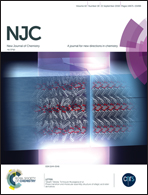Porous metal–organic gel assisted by l-tartaric acid ligand for efficient and controllable drug delivery†
Abstract
A novel Al-based metal–organic gel (Al-MOG), as a stable and controllable drug carrier, is assembled from bridging L-tartaric and Al3+ ions using a simple solvothermal method. The reaction temperature and the ratio of metal ions and ligands are vital for the formation of the gel. Transmission electron microscopy (TEM) and N2 adsorption measurements demonstrate the porous structure of Al-MOG, which exhibits Brunauer–Emmett–Teller (BET) surface area of 427.9 m2 g−1. The coordination between Al3+ and L-tartaric acid as well as non-covalent interactions could play a vital role in the formation of Al-MOG. Considering its large BET and excellent biocompatibility derived from low toxicity of the metal ions and the natural acid ligand, we further investigate the behaviors of Al-MOG for the controlled release of methyl salicylate (MS), an antimicrobial drug. The results of drug loading experiments show that the largest drug loading amount of MS reaches 31.8 wt%, whereas the release time of MS is over 600 min. In addition, the mouldability of Al-MOG further demonstrates its promising potential to act as a drug carrier.



 Please wait while we load your content...
Please wait while we load your content...